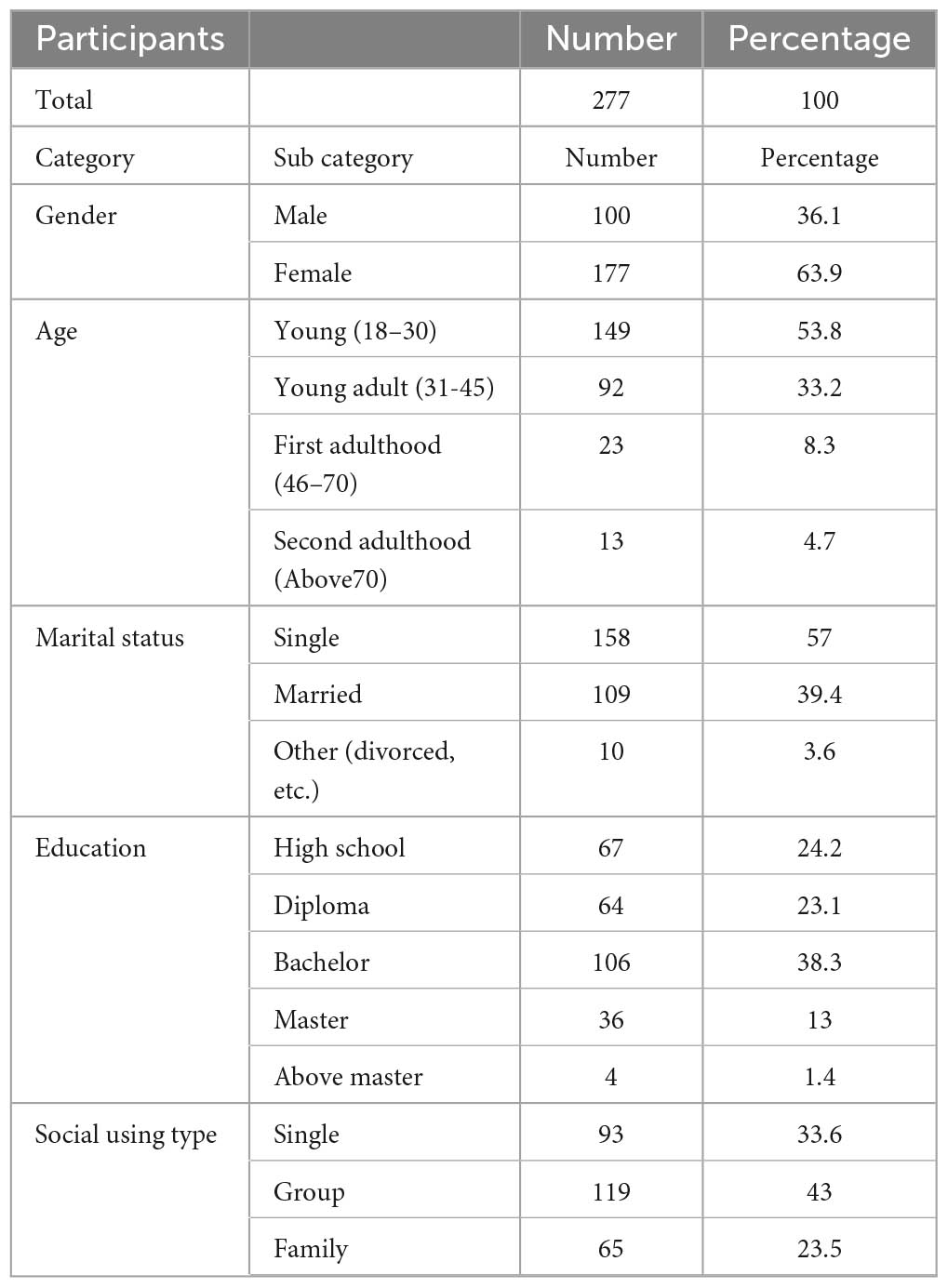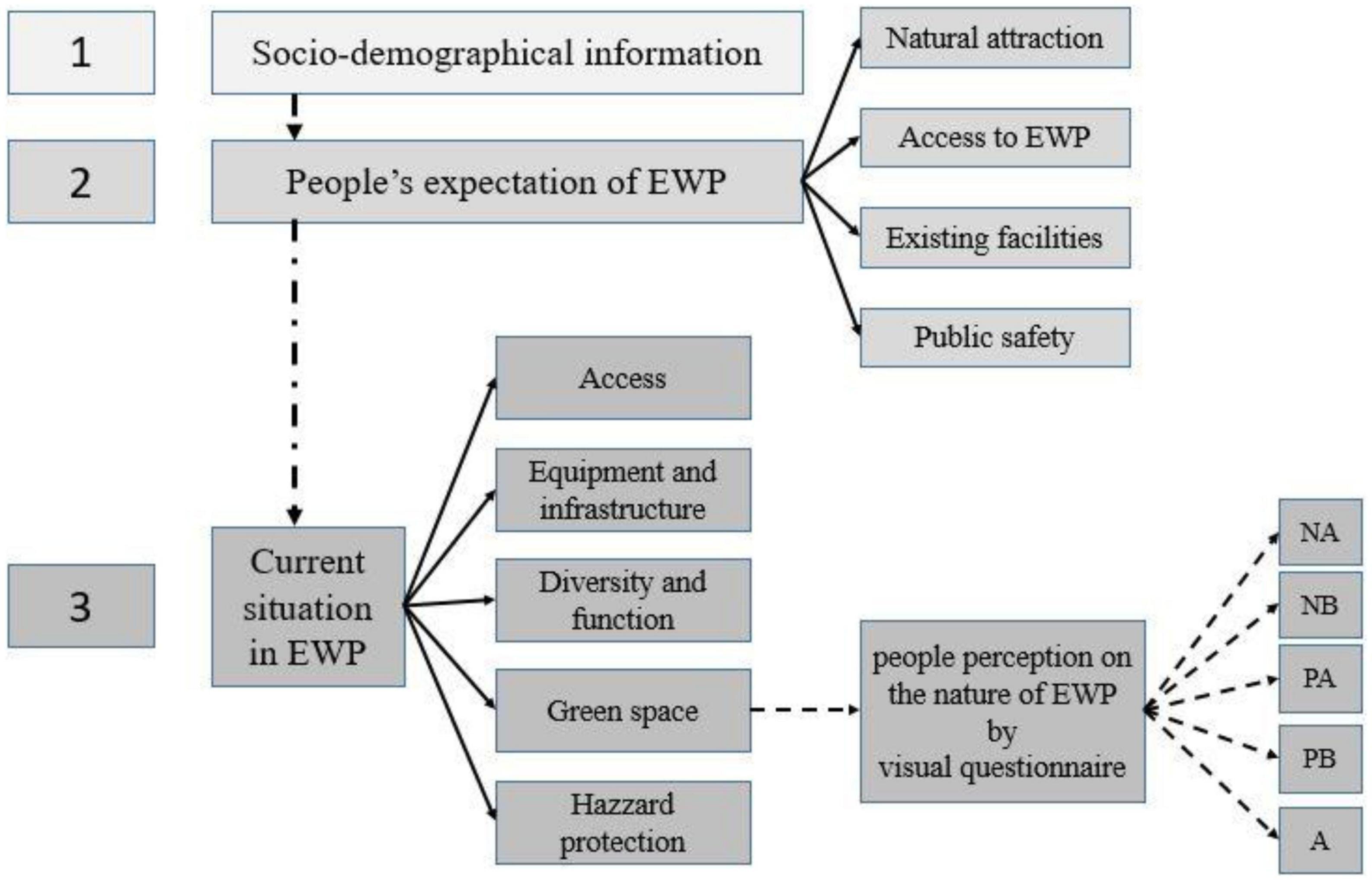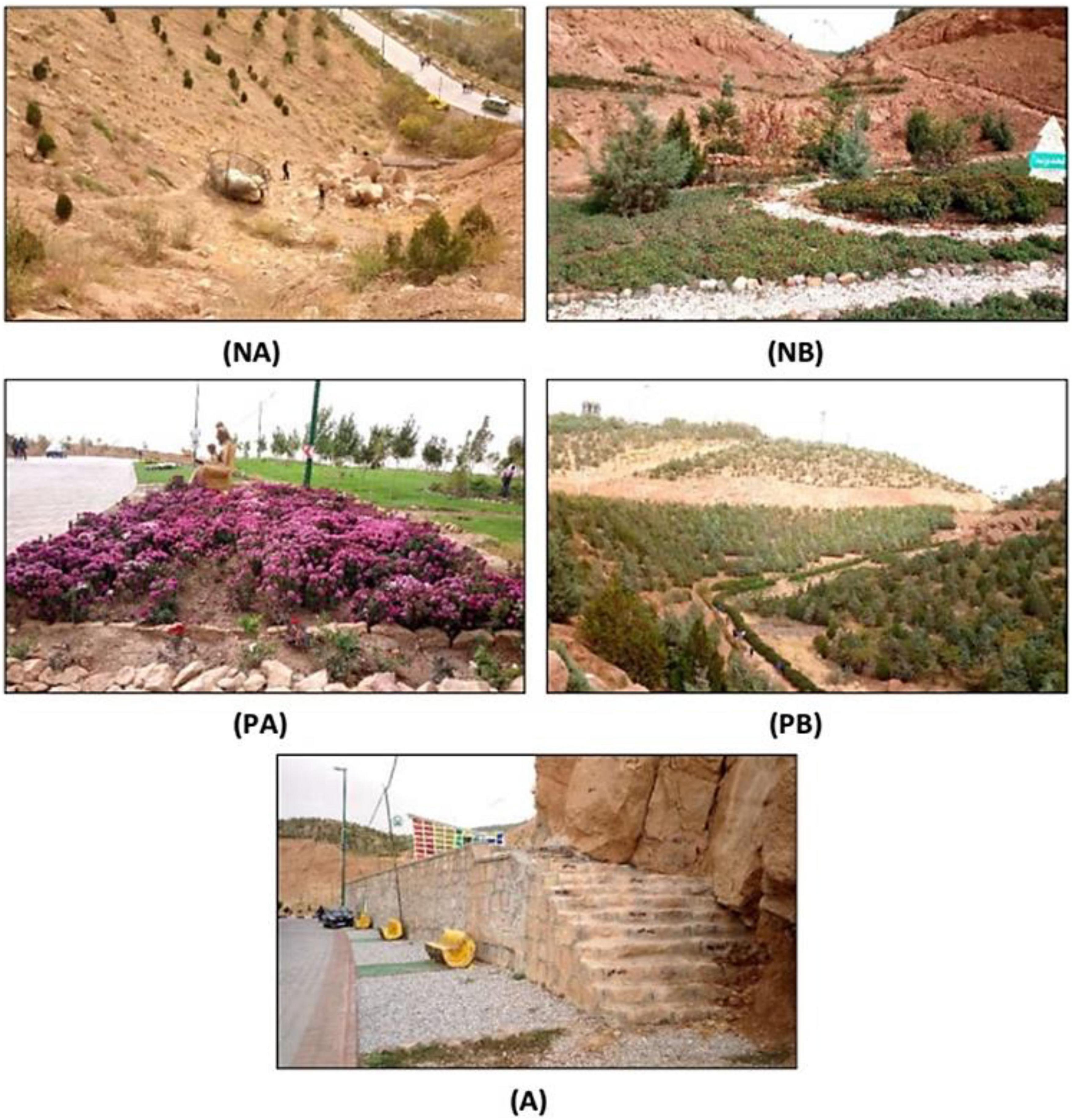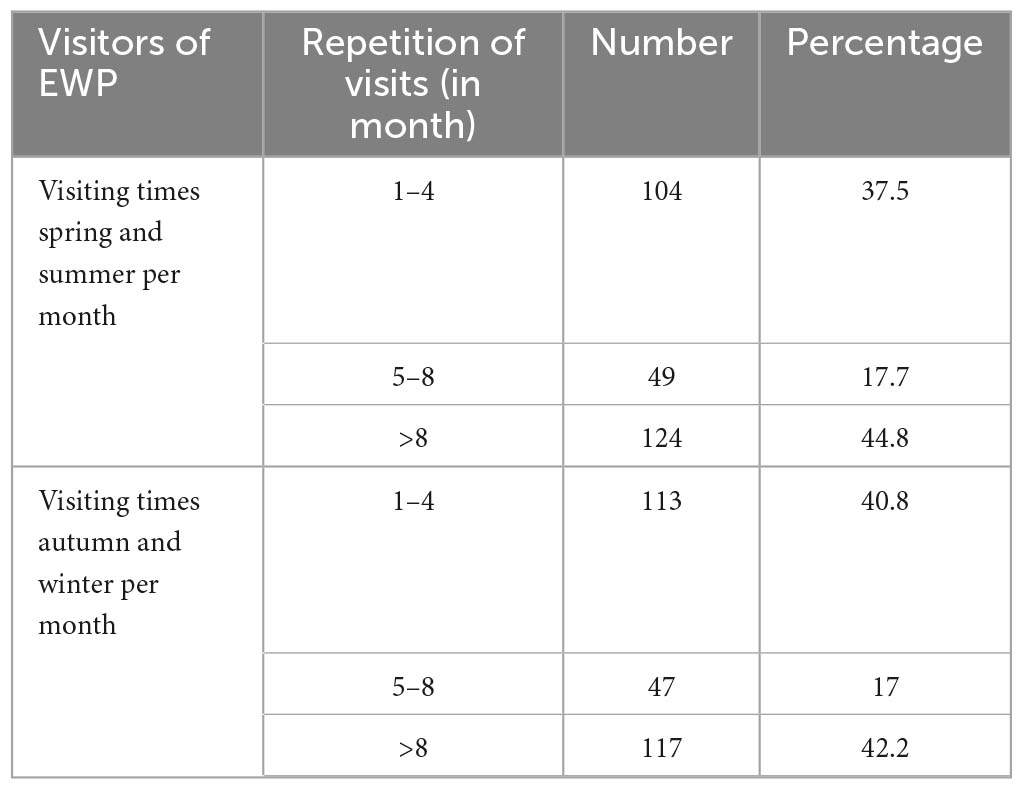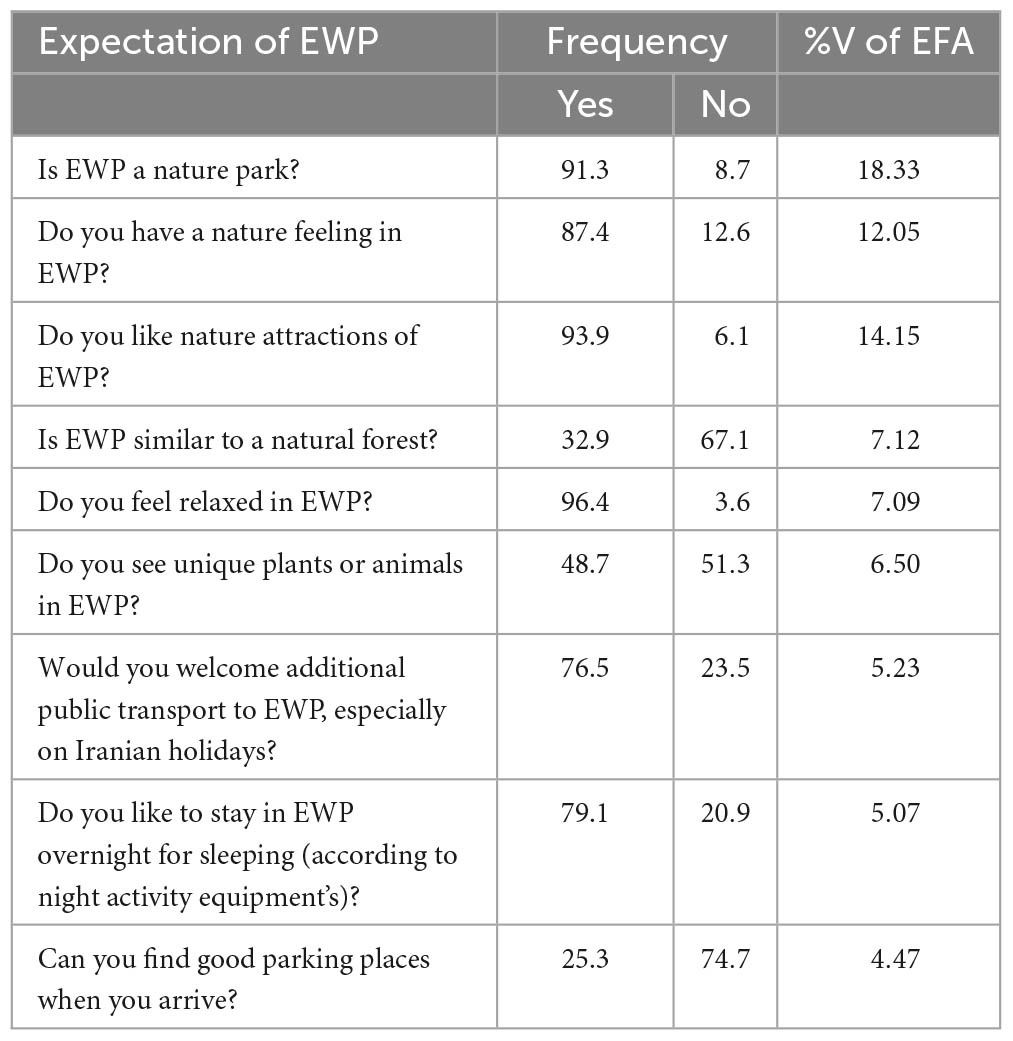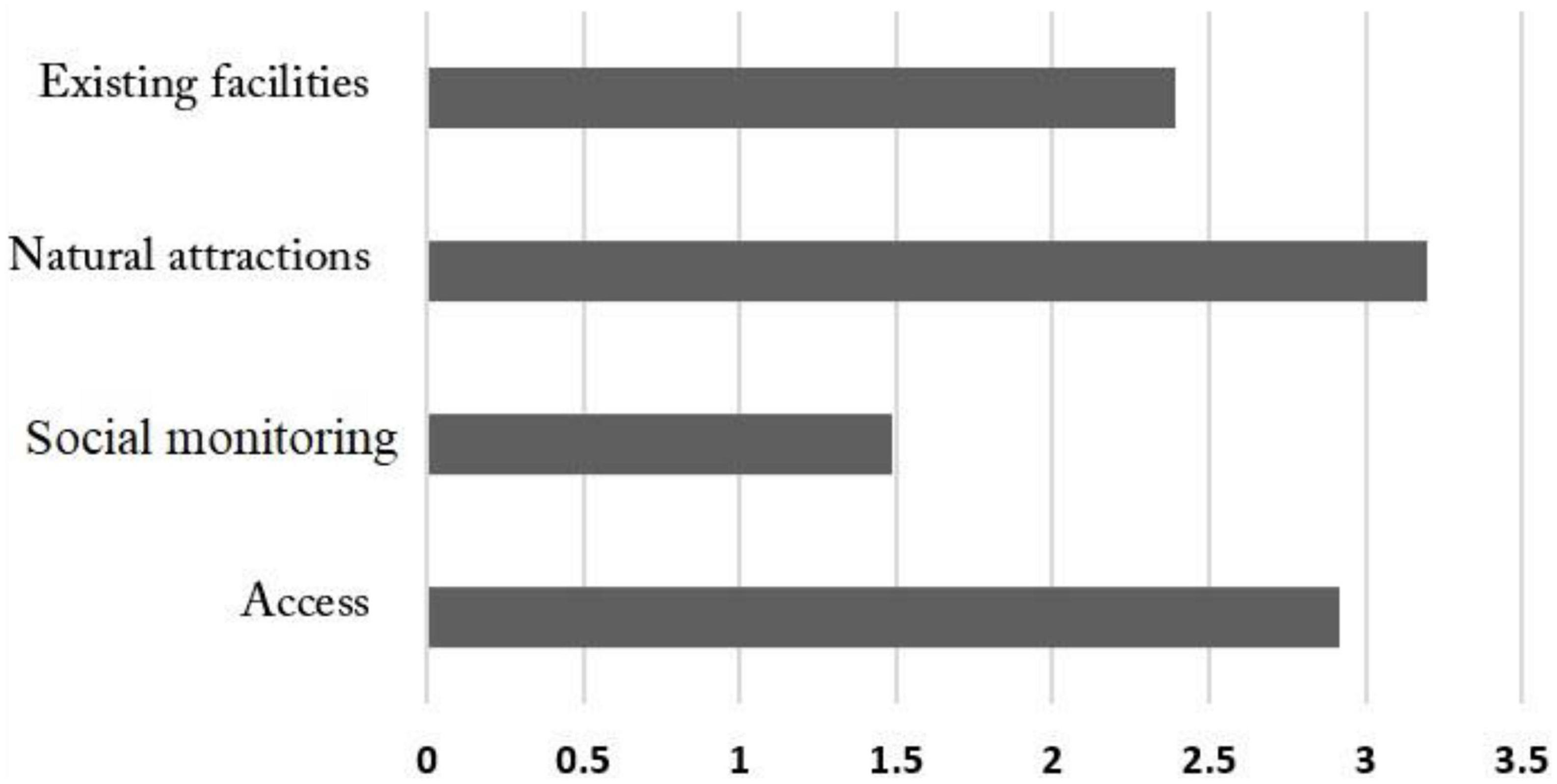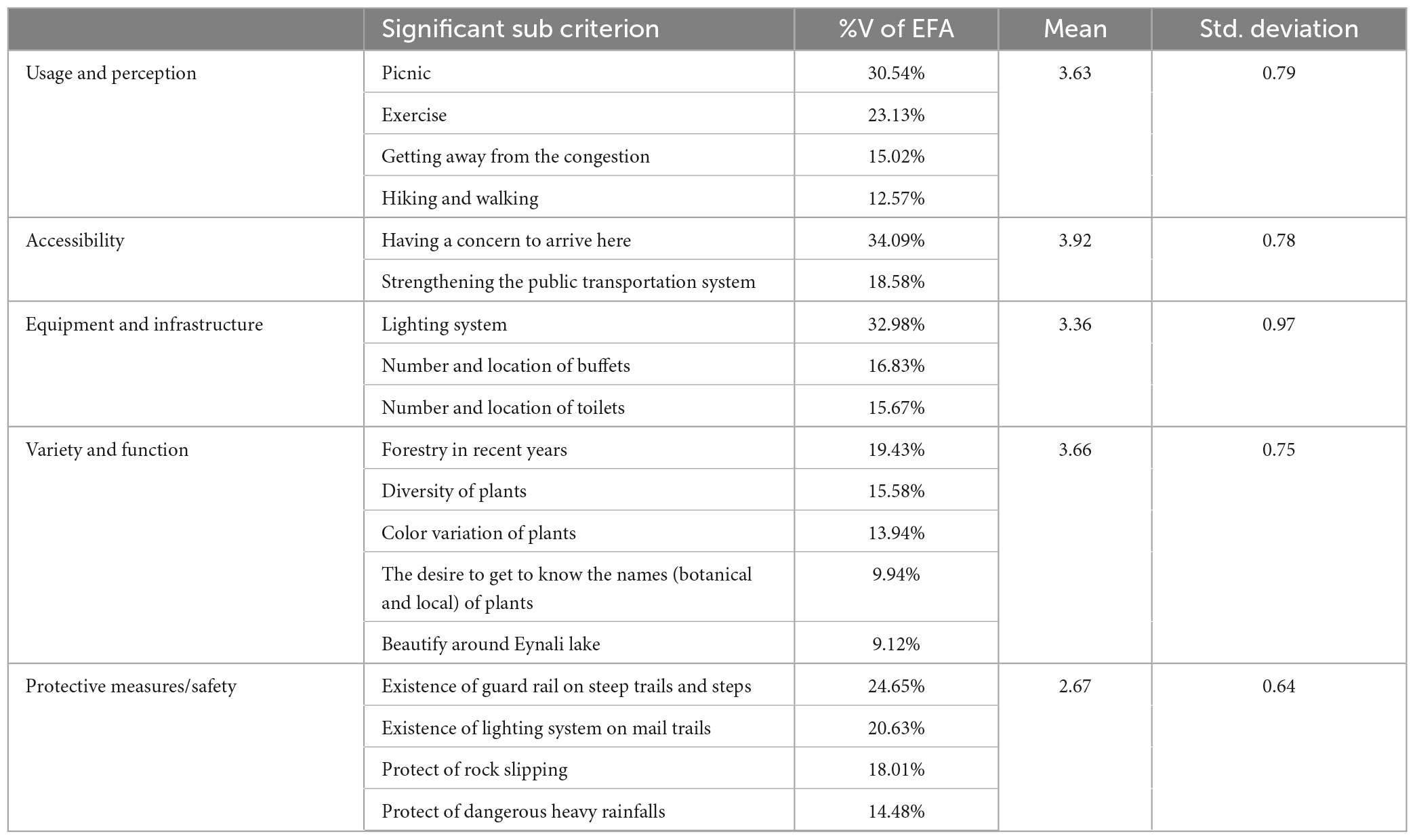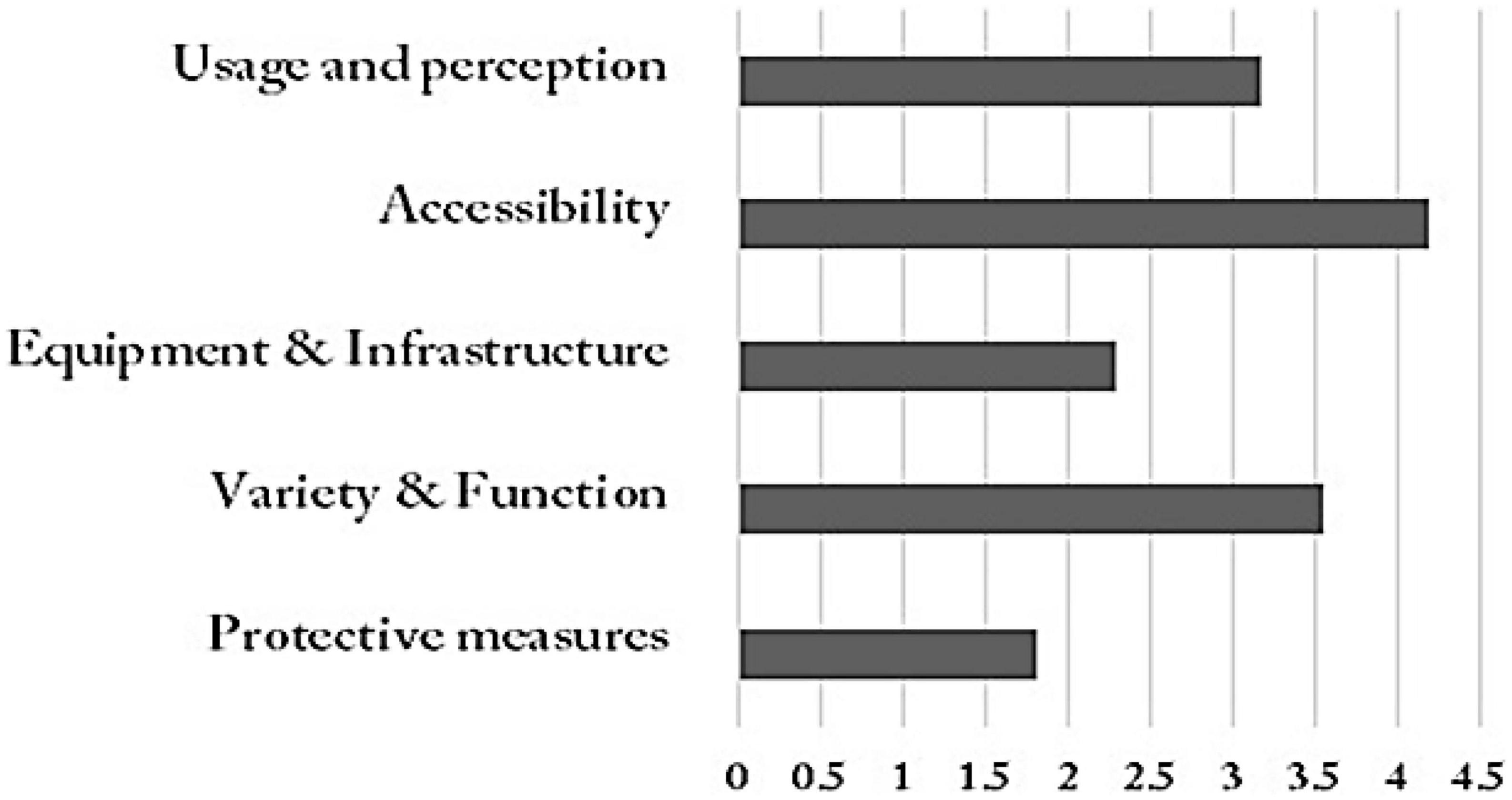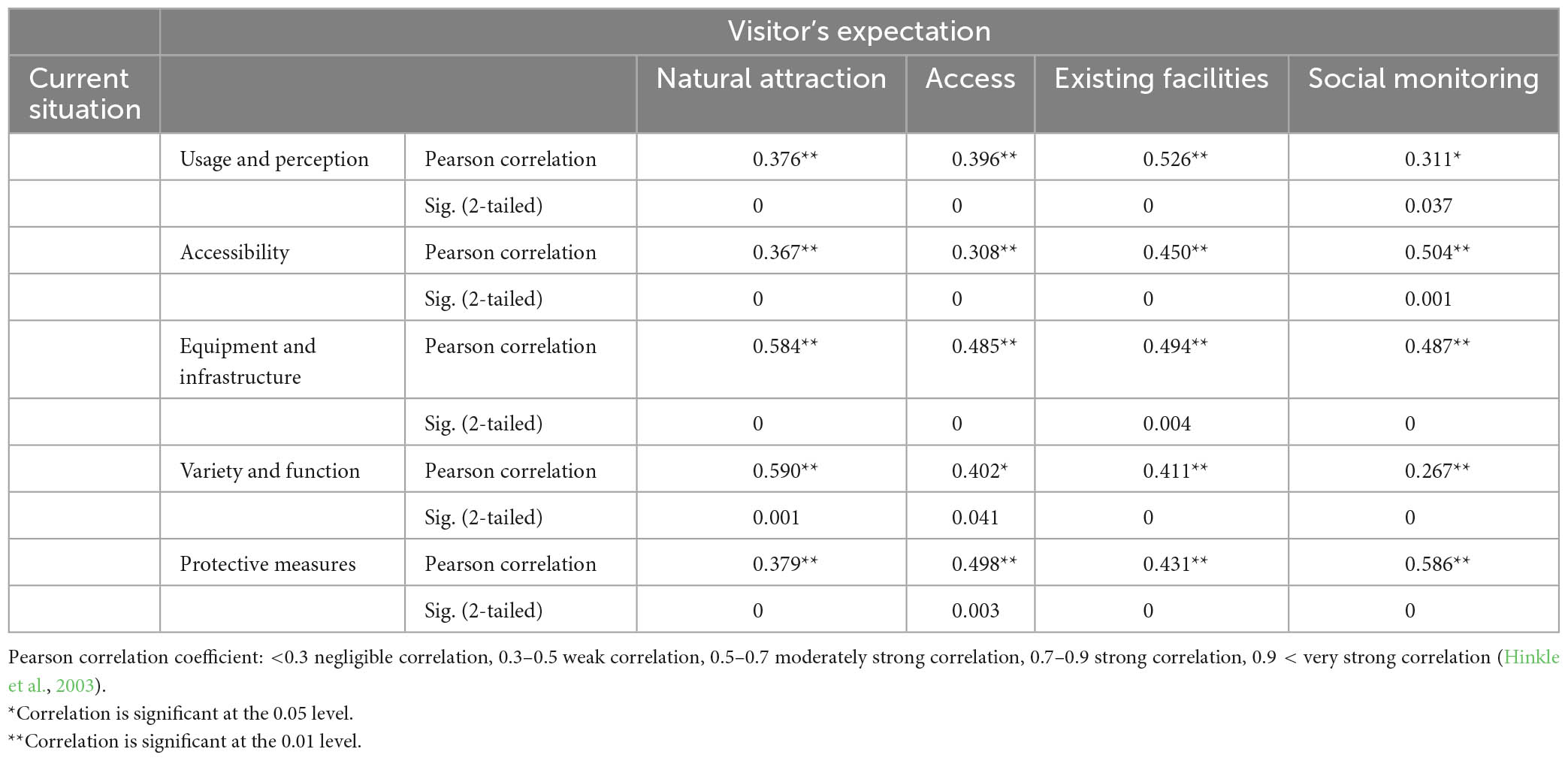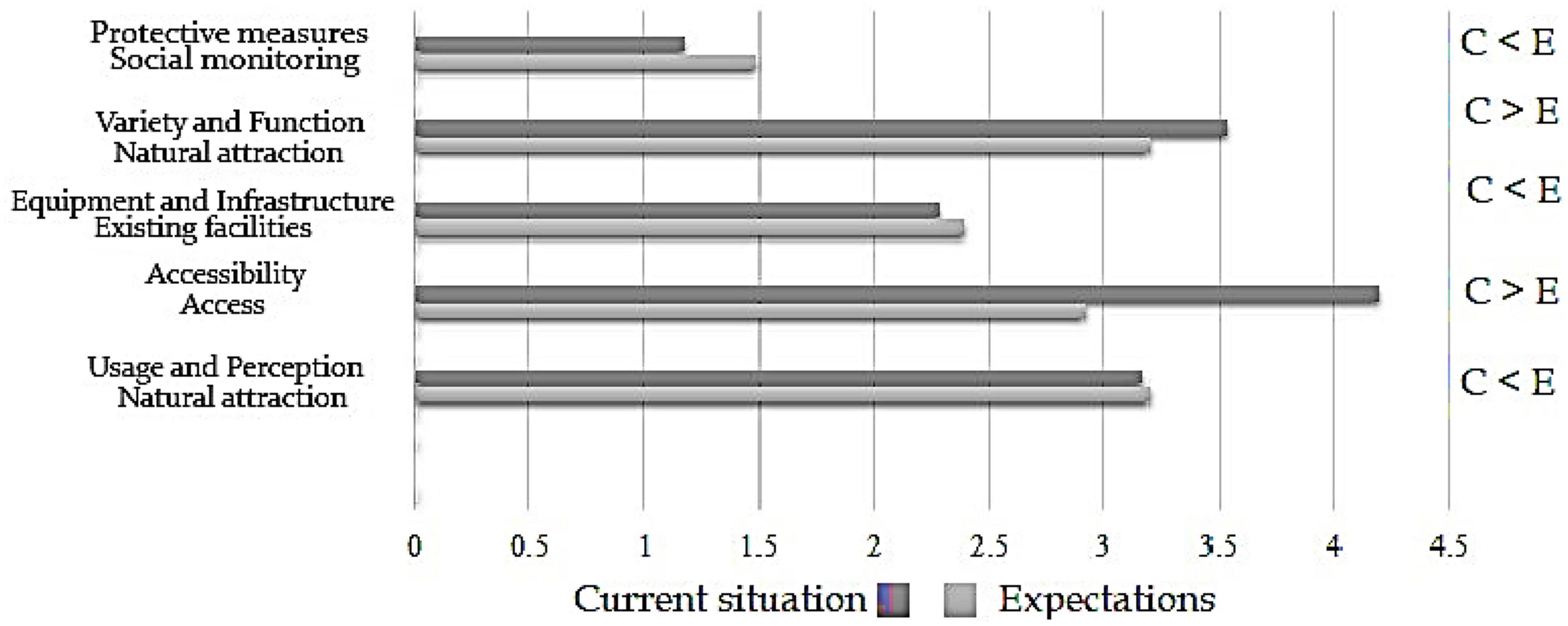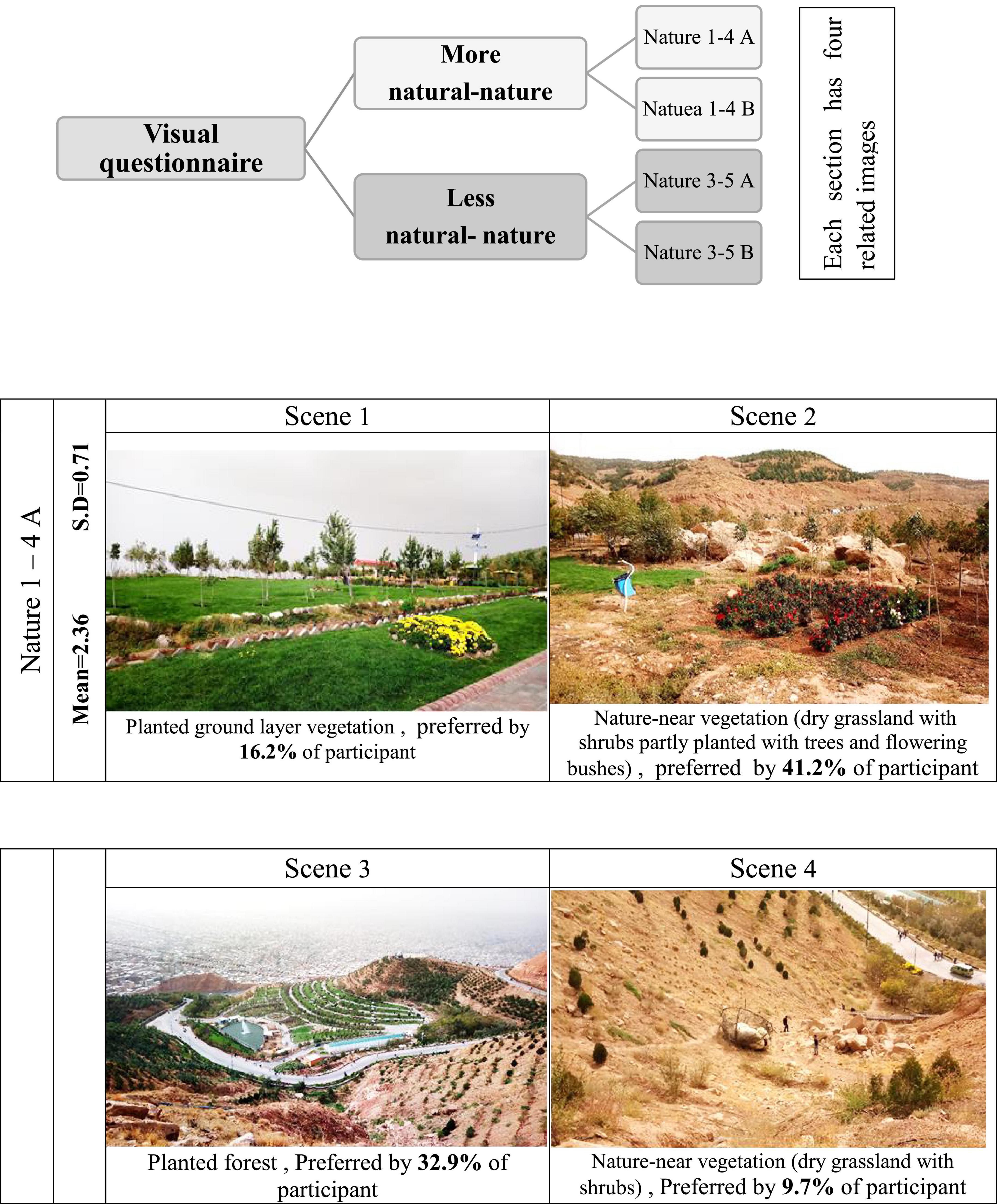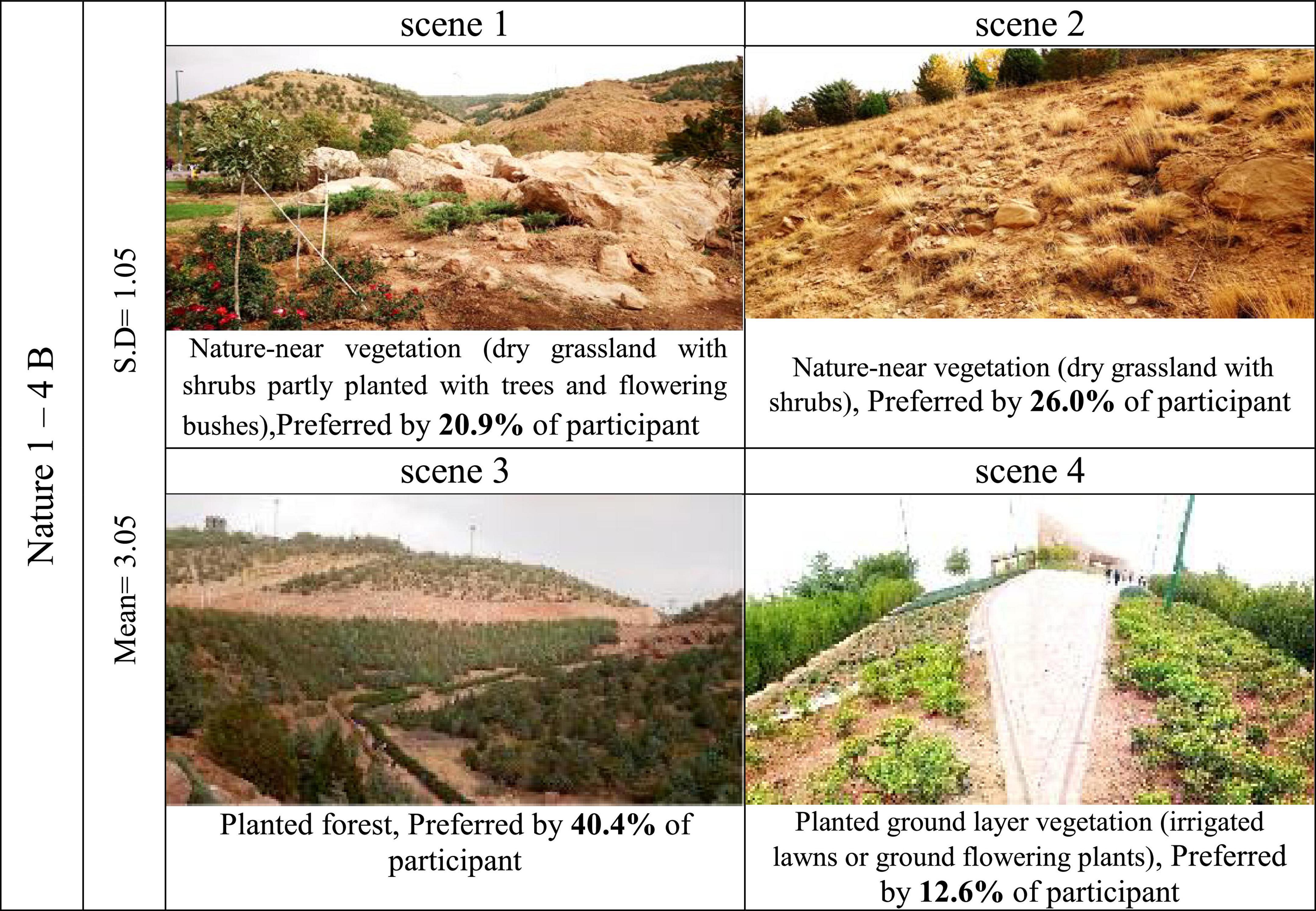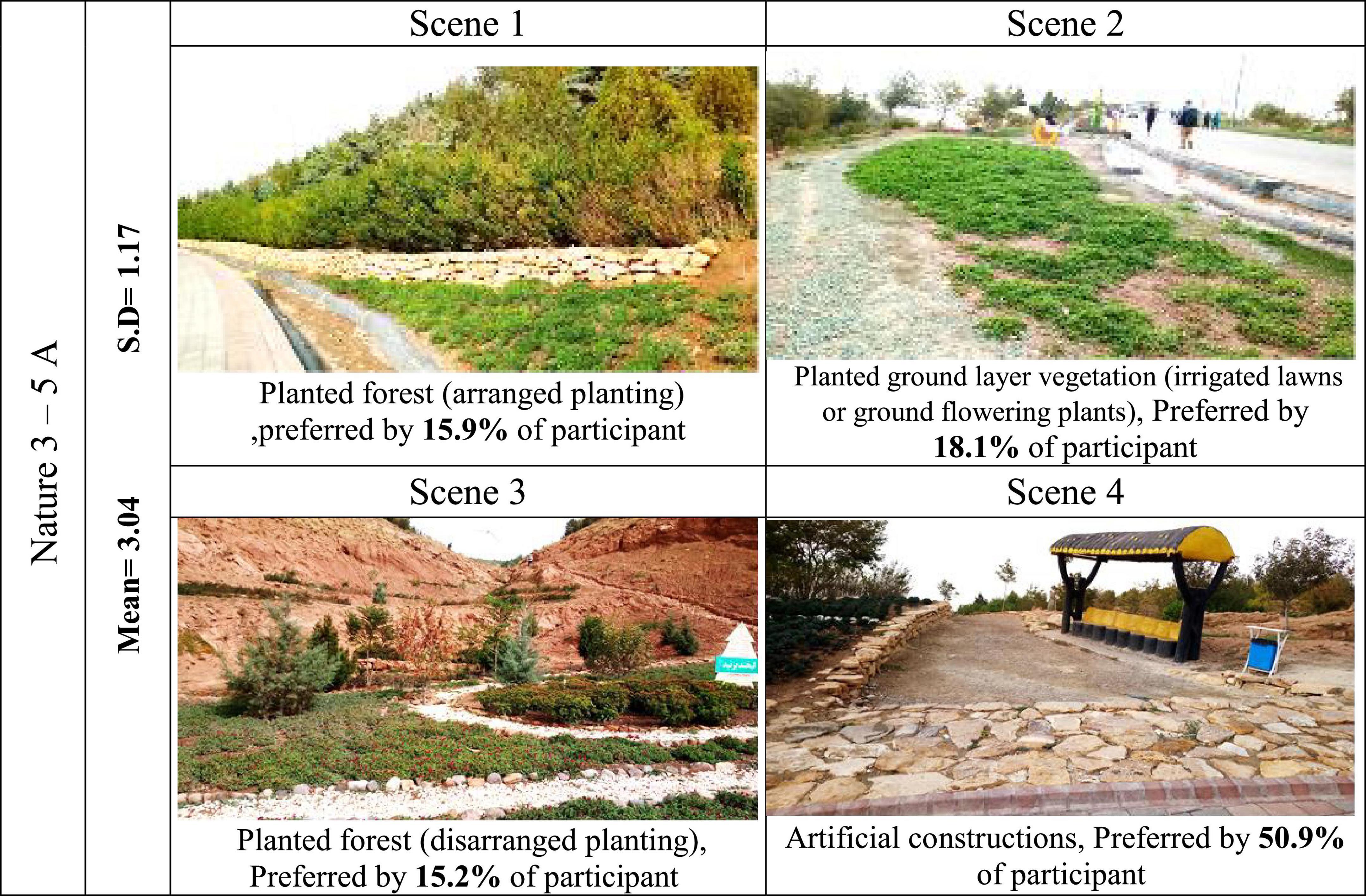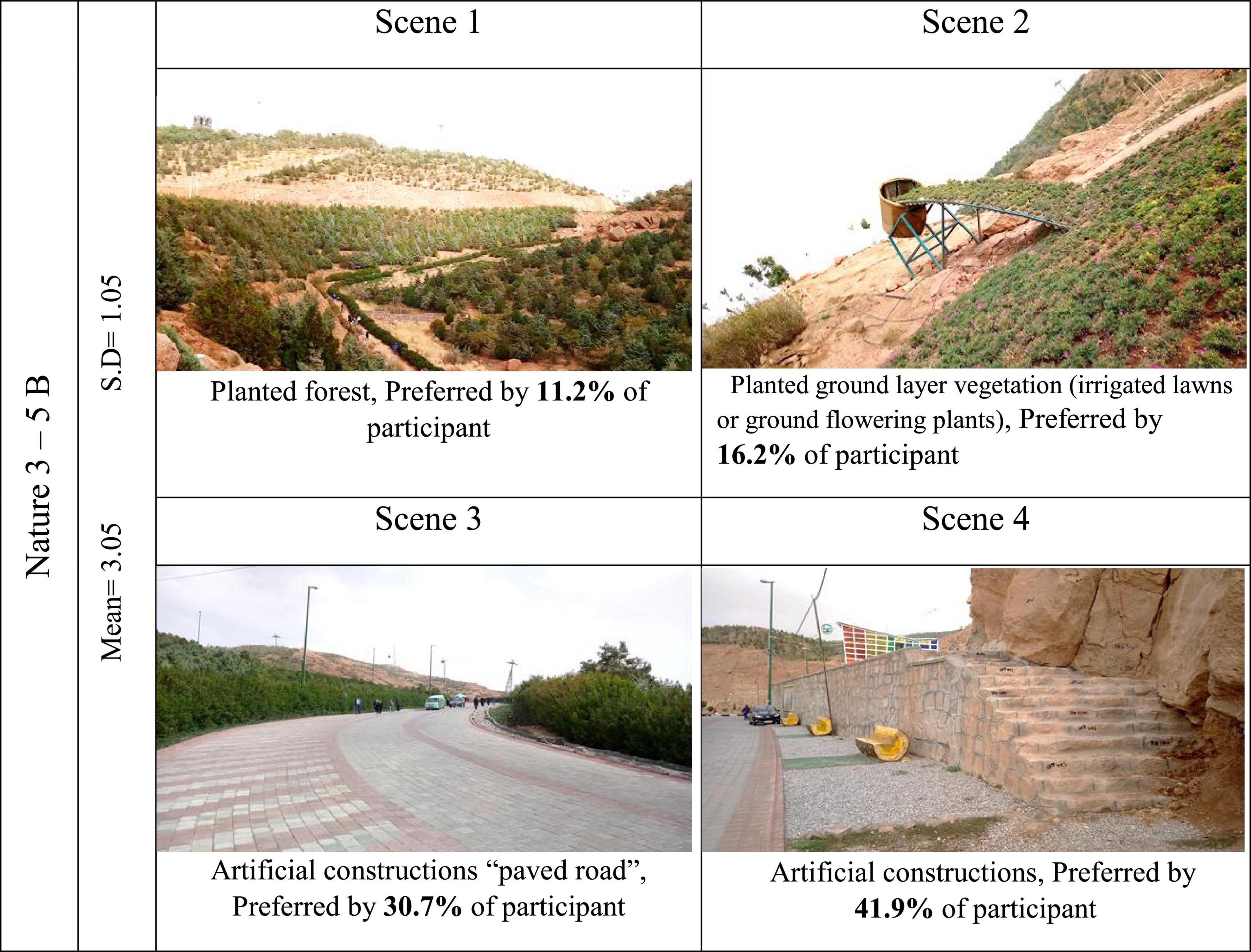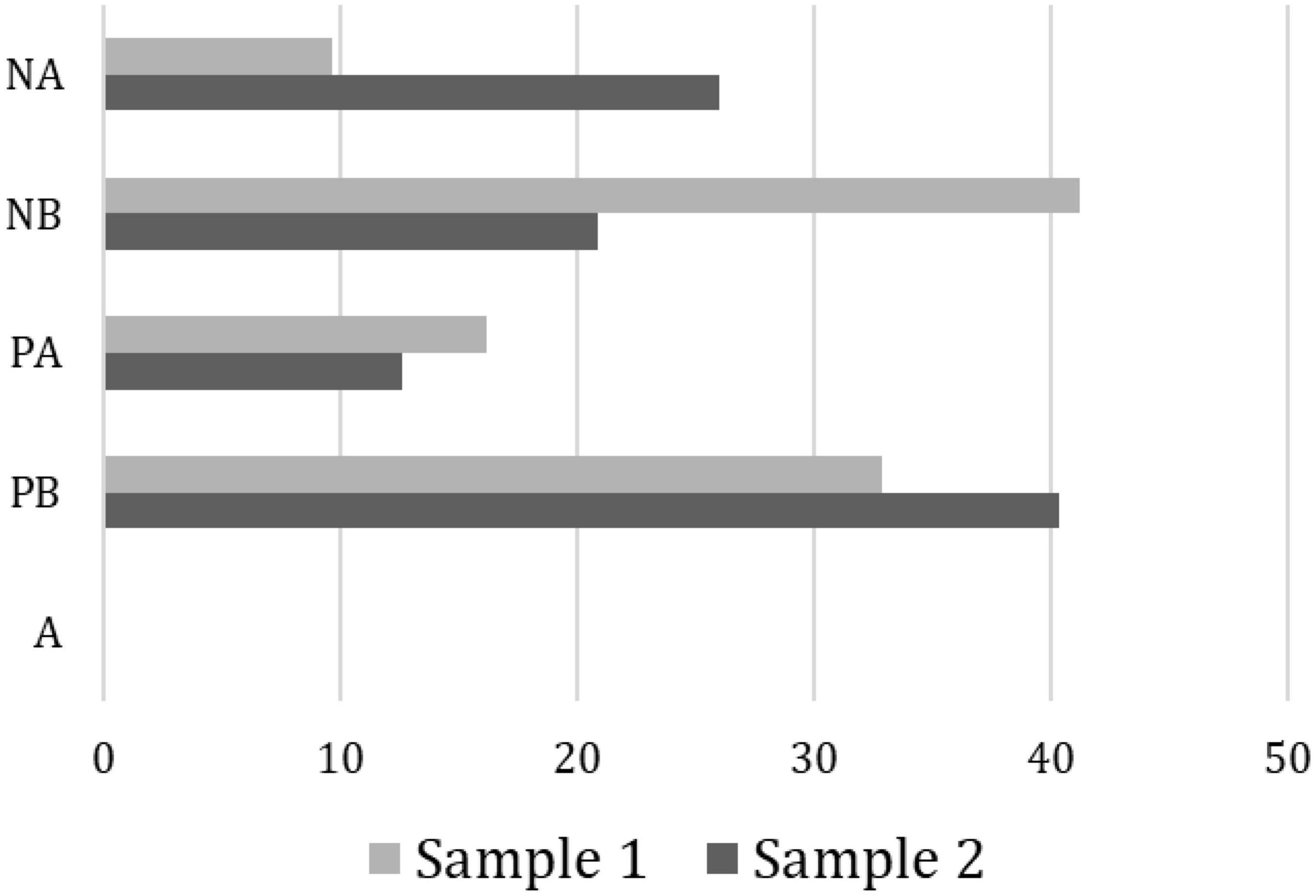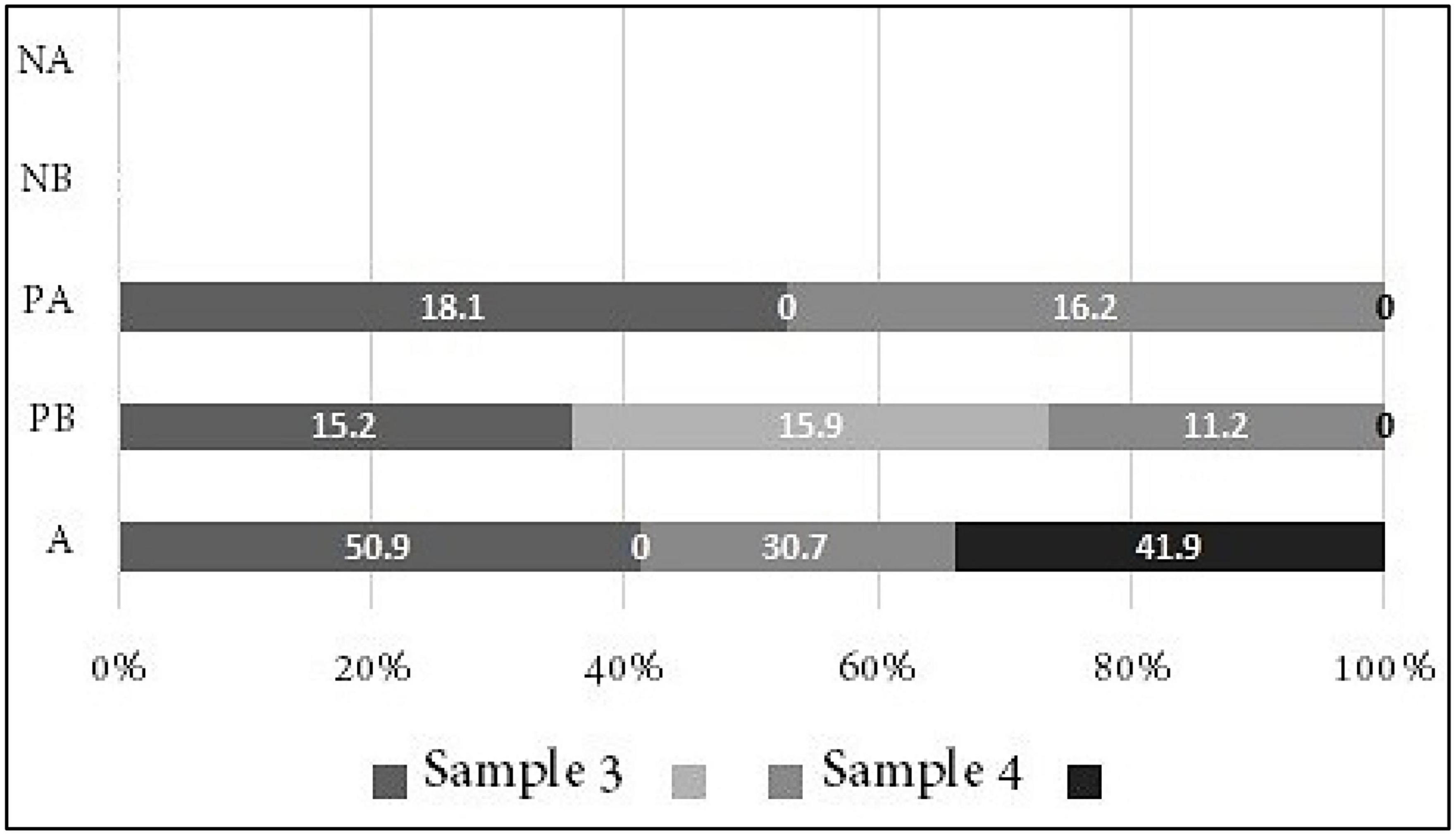- 1Department of Environment and Biodiversity, Urban Landscape Research Group, University of Salzburg, Salzburg, Austria
- 2Department of Landscape Engineering, University of Salzburg, Salzburg, Austria
- 3Department of Geography and Urban Planning, Faculty of Planning and Environmental Science, University of Tabriz, Tabriz, Iran
Eynali Urban Woodland Park (EWP) is a large mountain park in Tabriz, Iran, and is the largest urban woodland park in Iran. It was developed to increase the urban green space in the growing city of Tabriz for recreation, climate improvement, biodiversity, and ecological connection between the city and its natural surroundings. The planted hilly woodland is located in a natural mountain steppe in a semi-arid region and needs intensive management, including irrigation. By questioning 277 randomly selected park visitors’ frequency of visits, activities, accessibility, preferences, and especially nature preferences were analyzed using visualization of different nature types by photographs. The management targets were compared to visitors’ perceptions, preferences, and acceptances. The results show, that visitors prefer natural surroundings instead of artificial landscape design. Expectations of visitors for specific natural design attractions are lower than the actual status offers, and higher for social security, quality of infrastructure, accessibility, and utilization. Especially important are security by monitoring and guarding, enhancing picnic sites, improving the lighting system for evening visits, continuing forestry, public transport, and providing natural risk protection. Most visitors prefer nature-near vegetation, dry grassland with shrubs partly planted with trees and bushes, followed by planted forest. The planted forest is not the preferred preference. Vistors’ mental nature imagination matches quite well with the nature experience they have from the surrounding mountain steppe with forest patches. The use of the visitors’ expectations can improve the park landscape management can reduce the management costs.
1. Introduction
It is well documented that desired green spaces in cities could have positive psychological and physiological effects on citizens (Balram and Dragićević, 2005; Richardson et al., 2010; Madureira et al., 2015; Kobayashi et al., 2021). Indeed, urban green spaces can improve physical health, mental relaxation, professional efficiency, and lifestyle; however, this has been largely ignored in urban design (Özgüner and Kendle, 2006; Lee and Maheswaran, 2011; Buchel and Frantzeskaki, 2015; Li et al., 2020). As a result, mental health and social health are more compromised in urban areas than in rural areas (Barton and Pretty, 2010). Green spaces in cities compensate the negative impacts of stress as an ever-increasing complication of living in urban areas (Balram and Dragićević, 2005; Abuayyash et al., 2023). A clear focus of urban ecological research is on biodiversity and ecosystem services, energy consumption and sustainability, multifunctional landscapes (design and planning), and carbon footprint for climate change studies (Breuste and Qureshi, 2011).
Urban woodlands are typical elements of cultural landscapes. Mostly, they are managed by forestry. These areas typically lie on the urban periphery but can also be fully integrated within the city itself. Urban woodlands can either be publicly or privately owned. They are usually either natural woodlands or planted for commercial use. Aside from urban parks, urban woodlands are the most preferred urban green spaces by urban dwellers. For many people, they represent the type of “nature” which is normally missing in cities. Their accessibility is an essential prerequisite for the cultural ecosystem services they provide for the urban dwellers (Konijnendijk et al., 2005, 2006; Randrup et al., 2005; Konijnendijk, 2008; Leser, 2008; Gilbert, 2012; Johnson and Handel, 2019; Breuste, 2020). In many European countries, their continuity as woodland can be dated back to at least 250 years (Dzwonko, 1993; Hermy, 1994; Wulf, 1997), and in Great Britain even up to 400 years (Peterken, 1993).
Iran is predominantly an arid and semi-arid country, where, out of a total land area of 164.8 million hectares, 86 million ha (52.4%) are grasslands and pastures. Only 14.2 million ha (8.6%) are forests and woodlands, whereas 32 million ha (19.5%) are deserts including salt plains. The country receives an average annual precipitation of 240 mm (Revised National Biodiversity Strategies and Action Plan 2016-2030 (NBSAP2), 2016). Therefore, it is natural that there are no forested cities in most parts of Iran.
Urban woodland parks in Iran are infrequent and for a long time, Chitgar Park (built 1963–1969) on the western edge of Tehran was the only urban woodland park in Iran (Chitgar Forest Park, 2022). It covers an area of about 14.5 km2 and includes recreational infrastructure. The green belt of Teheran contains some other urban woodlands with urgently needed recreational facilities (Attarod, 2016). In Near Eastern and Middle Eastern countries due to a lack of precipitation and historical land cultivation this urban green spaces are rare. Examples are Belgrade Forest (Istanbul) (Akkemİk and Dağdevİren, 2000), (Daman-e-Koh hilltop park and woodland park) (Islamabad) (Bokhari et al., 2018), and Sisangan Forest Park (near Nowshahr, Iran). All of which are remnants of natural woodlands that have been equipped with infrastructure and developed into recreational parks.
Ghandehari et al. (2012) express that public urban parks in the Neared Middle East are influenced in design by international and park use. Woodland parks are new developments. Due to cultural and societal conditions, most park users are male, young and have an above-average level of education (Hami, 2009). Women were more likely to use parks with families or to walk with their children at the weekend. Women do not use the parks frequently because of some restrictions due to religious rules, financial issues, and family responsibilities. The majority of visitors in Sisangan Forest Park (near Nowshahr) are single college-educated persons (Kheiri et al., 2015).
The importance of urban woodland parks around the world and having positive and appropriate feedback in Iran among the people is seen in previous studies. Most people and visitors in the past researchers consider “urban woodlands” as one of the main urban green spaces in their leisure time. Therefore, designing, maintaining, and managing urban woodland parks is of undeniable importance. Thus, the purpose of this study is to examine visitors’ expectations and perceptions of urban woodland parks from various perspectives (green space and existing uses) and to compare them with the current situation so that better management and development can be achieved in the future in Eynali woodland park “EWP” (Tabriz, Iran). We are still attempting to answer the question: Do visitors and residents prefer “EWP” to city parks? EWP is most often visited as an individual, group, or family, and is this similar to visiting Tabriz city parks? What is the gap between visitors’ expectations and the current situation at Eynali woodland park? And, last but not least, which scenes of nature do they like and dislike?
2. Materials and methods
2.1. Study area
The city of Tabriz (1.56 million inhabitants) is located in northwest Iran (Yigitcanlar et al., 2020). Eynali Woodland Park (EWP) with 37°06’12.00” N 47°19’12.00” E, was established in 2004 on 5,612 ha mountain grassland of the Eynali mountain chain in the northern district of the city (see Figure 1), which 280.92 ha (= 5%) were planted with different types of bushland and trees in 13 zones until 2018 when the park was completed. The majority of planted tree species are non-natives: Robinia pseudo acacia (North America), Fraxinus excelsior (Europe), Ailanthus altissima (China), Elaeagnus angustifolia (Central Asia), Crataegus spp. (Europe), Morus alba (Europe), Pinus nigra (Mediterranean region), Thuja orientalis (China) - Cupressus arizonica (North America). Only two species, Gleditsia caspica and Pinus eldarica (Western Asia) are native. Apart from Rose spp., all planted shrubs are non-native. These include Pyracantha coccinea (Southern Europe, Asia minor), Cotoneaster dammeri (China), Berberis thunbergii (Eastern Asia), Ligustrum ovalifolium (Japan), Forsythia x intermedia (hybrid). (Development Organization of Eynali and Nature Park of Municipality of Tabriz, 2022; Latitude, 2022).
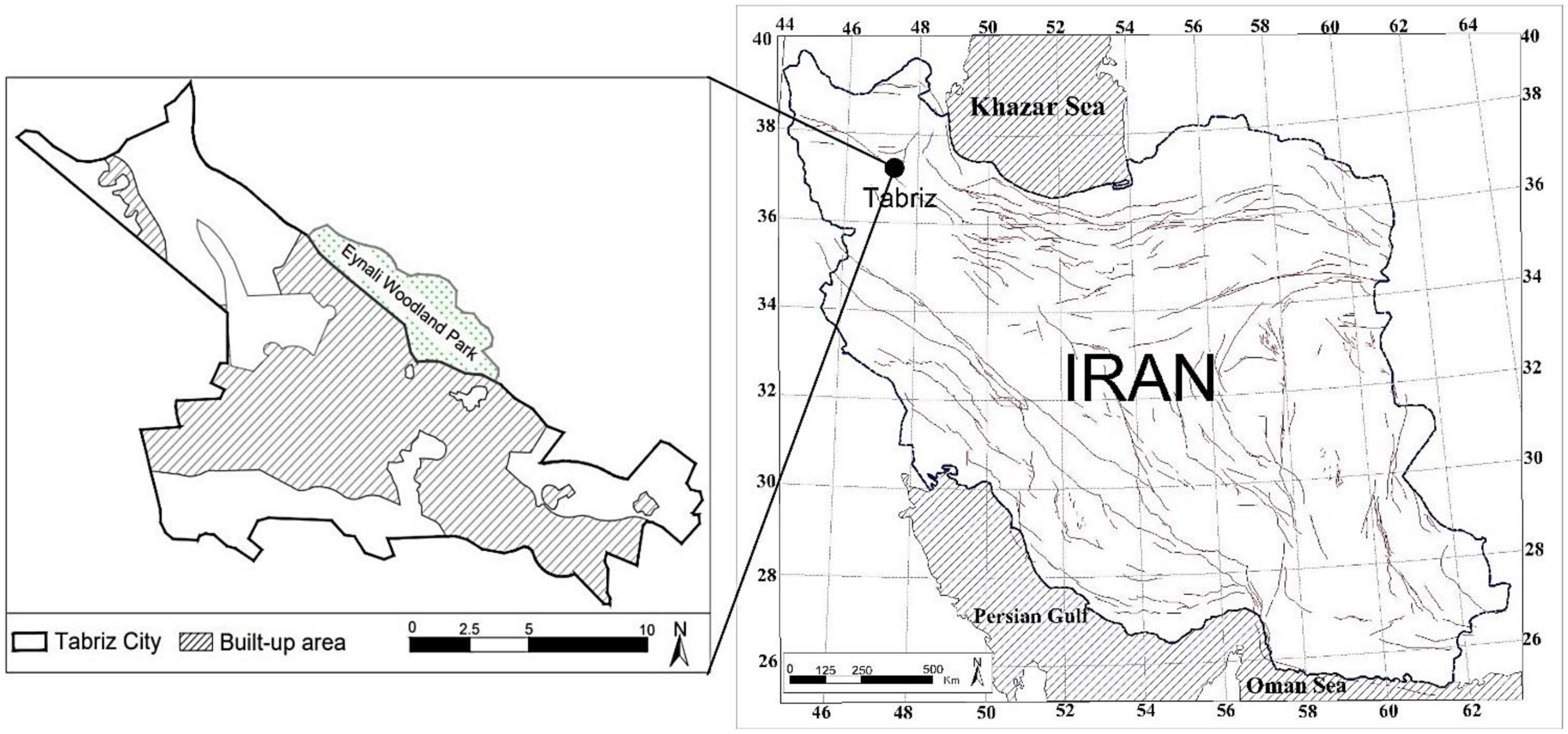
Figure 1. Two locations of Tabriz in Iran and Eynali woodland park in Tabriz (own design by the authors).
2.2. Questionnaire
A questioning of 277 park visitors provided information on visitors’ perception of EWP, preferred activities and evaluation of EWP’s infrastructure. The questioned persons were randomly selected, which were conducted in 2022 during June and July.
The Delphi technique was used to select the variables of the questionnaire. An independent group of experienced professors reviewed the variables in three phases and final approval of the authors of this research eventually questionnaire was categorized into three parts and consisted of 73 questions in total (7 demographic and general questions, 59 specialized closed questions, and 7 open questions).
First part: This contained socio-demographic information about gender, age (age groups), marital status, education level (six levels), visiting times (three options), and regular visits in social groups (single, group, or family).
Table 1 displays the demographical information of the questioned visitor sample. A big group of the questioned visitors were young men, single (33.6%) or in groups (43%), with high education level. Apart from family groups, this is the most present visitor group.
Second Part: This part included questions about people’s expectations of EWP. It has the following four sub-sections: natural attractions, access to EWP, existing facilities, and public safety (see Table 3).
- Feeling of nature in general (2 questions)
- Feeling of specific nature of EWP (3 questions)
- Feeling of recreation (2 questions)
- Transport connections (2 questions)
Third part: This was designated to the current conditions of EWP. There were five variables in this section: access, equipment and infrastructure, diversity and function, green spaces, and hazard protection (see to Figure 2). Four variables (excluding expectations of green spaces) were set in the Likert rankings. Questions were asked based on photos representing the various types of “green space.” Photos for the questions about “green space” were taken in the park on 15 June 2022. Image size was adjusted to 8.7 cm × 13.4 cm and brightness, contrast, color and other features were adjusted for all images using Adobe Photoshop CS software, as recommended by Wergles and Muhar (2009) and Daniel (2001). The selection of photographs for the study was carried out following the principles presented by Kaplan and Kaplan (1989) and Appleton (1975) (see to Supplementary appendices 1, 2).
The questioned visitors were presented with 16 pictures of scenes representing different nature types in EWP.
Each of the four pictures was presented. The used nature categories were:
1. Nature-near vegetation (NA) (dry grassland with shrubs).
2. Nature-near vegetation (NB) (dry grassland with shrubs partly planted with trees and flowering bushes).
3. Planted ground layer vegetation (PA) (irrigated lawns or ground flowering plants).
4. Planted forest (PB).
5. Artificial constrictions (A) (see to Figure 3).
2.3. Data analysis
Various analysis techniques, including descriptive statistics, measurement—validity, and reliability (exploratory factor analysis), ranking test (Friedman’s test), B-variate correlation, and means comparison tests (Independent Sample t-Test and One-Way ANOVA) were conducted using SPSS 23.0.
3. Results
3.1. Frequency of visits
There are two groups of visitors of nearly the same size - around 40% of the total (see to Table 2). One visits EWP about once a week, the other more than twice per week. There were no major differences between the frequency of visits between spring/summer and autumn/winter.
3.2. Visitor’s expectation of EWP
Nature, in general, is highly valued and was reported by more than 90% of visitors. Moreover, most visitors (more than two-thirds) know that EWP is artificial nature, and 87% value the artificial nature. However, only half of the visitors reported expecting something spectacular (unique plants or animals). Simple relaxation and no special interest in specific activities were expressed. For a majority (nearly 80%), a stay in cooler conditions after sunset or even overnight is very important. Due to these trends, refreshments are available until 2 am in the central part of the park.
Most of the visitors demand an improvement of the connections from EWP to the city by public transport but also improved accessibility by car and better parking options. Based on exploratory factor analysis (EFA), the priority for visitors was the feeling of “being in nature” and the attraction to the natural setting (see to Table 3).
The high number of visitors (nearly 70%) who access EWP with private vehicles further demonstrates the insufficiency of available public transport. Apart from regarding EWP as artificially designed nature, the experience/feeling of being in nature is considerable, as 44% reported this to be “high” and even “very high” by 23%. Together, two-thirds of the respondents feel that they visit ‘nature’ in EWP.
The feeling of being safe is also important for most visitors. They expect adequate local park safety and monitoring.
According to Friedman’s analyses, the most important expectations are natural attractions (mean rank = 3.20), followed by accessibility (mean rank = 2.92) and existing facilities (mean rank = 2.39). The least important criterion was “social monitoring” (mean rank = 1.49) (see to Figure 4).
3.3. Assessing the “current status” according to visitors’ opinions
Visitors reported the highest satisfaction regarding “access to EWP” (mean = 3.92, SD = 0.78) followed by “variety and function” (mean = 3.66, SD = 0.75), “usage and perception” (mean = 3.63, SD = 0.79), “equipment and infrastructure” (mean = 3.36, SD = 0.97) and lastly “public safety” (mean = 2.67, SD = 0.64). After differentiating the answers, a more detailed perspective is revealed (see to Table 4). The most important aspect for visitors was the ability to reach EWP (34%), followed by the availability of picnic facilities (30%), a lighting system (33%) for safe night use (21%) and guard rails on step trails and steps (25%). Information on the nature within the park (e.g., botanical names of plants) was not a priority (10%).
According to Friedman’s analyses about the current situation ranking (see to Figure 5), visitors reported the most satisfaction regarding the accessibility of EWP (mean rank = 4.19), followed by its variety and function (mean rank = 3.54), usage and perception (mean rank = 3.17), equipment and infrastructure (mean rank = 2.29), and are least satisfied with its safety (mean rank = 1.81).
The result of B-variate correlation for visitors’ expectations and the current situation in EWP (see to Table 5) showed a moderately strong correlation (r = 0.526, α = 0.000) between usage and perception with the existing facilities in the current situation. Also, a moderately strong correlation (r = 0.504, α = 0.001) was revealed between safety for visitors and the current accessibility, a relatively strong correlation (r = 0.584, α = 0.000) between visitors’ expectations of natural attractions with equipment and infrastructure. This means that, according to visitors’ opinions, having the right infrastructure can increase natural attractions, as observed by a moderately strong correlation (r = 0.590, α = 0.001) between natural attraction and variety & function, and a moderately strong correlation (r = 0.586, α = 0.000) between social monitoring and protective measures. All correlation is significant at a level of 0.01.
3.4. Comparison between the expectations of visitors and the current situation
The expectations were compared with the current situation in EWP based on visitors’ opinions and compared to each section as an index to separate them (see to Figure 6):
(i) Safety/Protective measures in the current situation is lower than the expectations of visitors regarding public safety by social monitoring therefore, the visitors are not satisfied with the current level of safety provided in EWP.
(ii) Regarding the attractiveness of nature, the level of satisfaction with the current situation is higher than the average visitor’s expectations; this means that by using variety and function has been successful at satisfying the visitors’ attraction to nature.
(iii) The facilities do not quite meet the expectations and visitors are less satisfied with their current situation (facilities and infrastructure) compared to their expectations for existing facilities.
(iv) The accessibility of EWP largely meets the expectations and the results show that visitors are more satisfied with the current situation of accessibility inside EWP compared to their expectations. However, how to get to EWP is still a concern.
(v) There is very little difference in this criterion between people’s expectations and the satisfaction with the current situation.
3.5. Visitors’ preferences of EWP’s green space (visual questionnaire)
Eynali Urban Woodland Park offers different sceneries regarding the arrangement of natural and artificial elements, a large variety of plants, and landscape designs. However; so far, no academic studies have been conducted on the interests, perceptions and attitudes of visitors in this regard. For this section, 16 images categorized into 4 sections were selected (Nature 1-4 A, Nature 1-4 B, Nature 3-5A, and Nature 3-5 B) (see Figures 7–10).
3.5.1. Visitors’ preferences of nature in “more natural—nature” combinations
In the first sample; Nature-near vegetation “dry grassland with shrubs partly planted with trees and flowering bushes” NB (41.2%) is the most preferred nature type, followed by “Planted forest” PB, (32.9%), Planted ground layer vegetation “irrigated lawns or ground flowering plants” PA (16.2%), and Nature-near vegetation “dry grassland with shrubs” NA (9.7%). In the second sample of “more natural nature” combinations PB (40.4%) is preferred most, followed by NA (26%), NB (20.9%), PA (12.6%) (see to Figure 11).
3.5.2. Visitors’ preferences of “less natural—nature” combinations
In two further samples (sample 3 and 4), the nature-near vegetation “dry grassland with shrubs” (NA) and nature-near vegetation “dry grassland with shrubs partly planted with trees and flowering bushes” (NB) were excluded but “artificial constructions” (A) were added.
In the sample 3; Artificial constructions (A) (50.9%) in the less preferred nature, followed by Planted ground layer vegetation “irrigated lawns or ground flowering plants” PA (18.1%), Planted forest “arranged planting” (15.9), and Planted forest “disarranged planting” (15.2%). In the fourth sample; artificial construction A (41.9%) in the less preferred nature, by followed artificial construction “paved road” A (30.7%), Planted ground layer vegetation “irrigated lawns or ground flowering plants” PA (16.2%), and planted forest (11.2%) (see to Figure 12).
Table 6 shows the preferred types of nature in the two combinations.
4. Discussion
4.1. EWP is different to public parks in size, structure, and utilization opportunities
More than 44% of visitors visit EWP in spring and summer, while 42% visit in autumn and winter more than 8 times per month. This shows a very intensive use of the space all year round. The visitors tend to come to EWP mostly on weekends (Iranian weekends) and prefer to stay overnight in certain park areas. Furthermore, Mahmoudi and Daneh-kar (2009) also shows that most visitors (30%) come to urban forests in Lordegan city (Iran) 8 times per month, which further supports the hypothesis that most Iranians prefer urban woodlands and urban forests compared to urban parks as long as they are available around their cities, which is especially rare in the north of the country and only possible in the mountains.
As Hami (2009) reported on only one-time visits to public urban parks in Tabriz and the same results by Malekian and Pouryazdi (2015) in Qom city (Iran), by the majority of visitors. It also shows the attractiveness of the park compared to others. In comparison, Tyrväinen et al. (2007) found that, under northern European conditions with long and cold winters, urban woodland parks were visited in Finland all year round, with a high frequency of use of two to three times a week (80% of visitors) during the summer.
4.2. EWP attracts a greater variety of user groups than traditional public parks
Most of EWP visitors are mostly groups of young male or female. Most participants are women, often single and well educated. This is related to results of traditional inner city public parks different, where the majority of visitors are families (Hami, 2009; Malekian and Pouryazdi, 2015). This is also controversy to the results of Hami (2009) who states that for public parks in Tabriz women mainly do not visit public parks alone because of cultural tradition. Tyrväinen et al. (2007) who investigated woodland parks in Finland under very different cultural and societal conditions counted that 61% of the visitors were women. Also, Palliwoda et al. (2017) found that the most frequent visitors of urban parks in Berlin (Germany) are women.
The results could be interpreted that EWP is as a unique area, different to traditional parks in location, size and structure, thereby bringing forth-different utilization behaviors and attracting different visitor groups. The woodland park is less likely to be overlooked, and therefore offers more social freedom making it especially attractive for groups of young people who come there for social activities with less supervision and more control. For this reason, there is a hypothesis stating that the number of groups (of friends) who visit this park is greater than in other parks (Malekian and Pouryazdi, 2015). Another reason could be a cultural behavioral change in the young people of Iran (Mirkarimi et al., 2016).
4.3. Visitors’ expectations and satisfactions
Most of the visitors come to the parks to walk, socialize, and engage in passive recreations. Eng and Niininen’s (2005) found as that the visitors’ expectations are to (i) be in a protected natural environment, (ii) have recreational places for children, (iii) attractive illumination of the park, and (iv) good maintenance. Jim and Chen (2010) register the visitors’ expectations in regards to beauty of plants, cleanliness and order, and adaptation of spaces to human needs. These expectations are also shared by the visitors of EWP. Besides the many leisure activities offered in EWP, the visitors had more expectations than what was offered in the park in four sections: attractiveness of nature, accessibility, facilities, and public safety. The different findings in our study compared to other studies are based on the fact that visitors see EWP as a part of nature, and only secondly, they expected extraordinary attractions such as plant arrangements or specific animals. Visitors of EWP experienced a sense of being “in nature”, even when they knew they were in a designed landscape. This means their mental ideas of being in a controlled, clean, and riskless nature were fulfilled.
Five criteria were important for the satisfaction of EWP visitors: accessibility, variety and function, usage and perception, equipment and infrastructure, and protection proceeding.
Visitors are relatively satisfied with the “internal access” in EWP. Visitors generally liked “variety and function” in the current situation of EWP. This means that the actual management status of landscaping, utilization and forestry (including tree planting) is accepted well. This is in line with the findings of Hami and Maruthaveeran (2018) who claimed that people prefer more trees in urban parks. EWP’s visitors showed a strong support of the construction of picnic places and rest areas. This is comparable to the results of Hayir-Kanat and Breuste (2019); Kart (2005); and Sezer and Akova (2016). Most visitors of public parks and resorts in Turkey are highly interested in relaxation, picnics and walking along lakes and waters.
Visitors are relatively less satisfied with “equipment and infrastructure.” Their biggest concern is the insufficient lighting system and the elimination of intimidating and unsafe spaces at night. Loukaitou-Sideris et al. (2016) study of Los Angeles showed that lighting is one of the most important equipment and infrastructure features in urban parks and their absence causes fear among visitors and lead to less visits after sunset. Hilborn (2009) shows that a proper lighting system in public parks and promenades lowers vandalism in the USA.
However, EWP visitors were least satisfied with the “protective proceeding,” which means that they have noticed the dangers in this area and that no action has been taken by the management to eliminate them. Reduction of such risks in hilly and mountainous areas like EWP is important. The risks can be stone falls, trails on steep slopes, mudflows after heavy rainfalls, and the danger of wear at exposed points. The protection level in EWP is very low and this is noticed and criticized by its visitors. In traditional public parks, this is much less a problem (e.g., Palliwoda et al., 2017 in Berlin) but Tyrväinen et al. (2007) displayed in Helsinki (Finland) that a certain degree of protection and safety in woodland parks also were expected.
4.4. Nature perception
Most visitors prefer planted forest followed by the nature-near vegetation - dry grassland with shrubs partly planted with trees and flowering bushes in the first and second simples of “more natural—nature” combination (see to Table 7). This is based on their experiences and knowledge of the region, which has both forest and mountainous grassland. It is no surprise that they identify with and value them both as a natural part of EWP, also in typical combinations as at many places in mountains to see, in steep valleys shrubs and trees, on ranges and plateaus grassland and mountain steppe. Even urban dwellers still have close relation to the countryside live and nature and welcome to find these nature elements in EWP. Planted forest nature (PB) patches allow in scene 3 (Figure 7), scene 3 (Figure 8), scene 1 (Figure 9), and scene 1 (Figure 10) “walking with a group or family and sitting in places where they can see this view.” Also, Hami (2009) showed big and old trees and water views as visitors’ preferred view in the urban parks of Tabriz as it is valued for relaxing and having a picnic in the shade of those trees while enjoying the view of the water. Watching wildlife, having waterfront views, and seeing beautiful plants have also been shown as a strong preference among visitors in the studies of Rodiek (2002), and Talbot and Kaplan (1991). Also, Hayir-Kanat and Breuste (2019) came to the conclusion that visitors tend to prefer habitat heterogeneity (nature area on the seaside, nature area near a lake, forest area and an urban park) in nature and value to “stay in nature” when relaxing. Visitors to the EWP agree that the most unnatural nature is “artificial constructions” (Mean = 41.16) that can’t be seen naturally in urban woodlands, and most people do not have positive feedback on this issue. Therefore, it should be handled with more sensitivity and comprehensively planned; Designed and implemented various elements and views in urban woodlands park.
5. Conclusion
The design and management of green spaces, especially woodlands in semi-arid cities like Tabriz, is a huge investment and should meet the visitors’ perceptions and expectations on such natural conditions and infrastructure. To investigate visitors’ perception of nature and to include this into designed nature like in an urban park is an important research subject, hence the objective of this research project. It was expected for people to have a strong preference for woodland nature as this normally is not available in and around semi-arid cities where grassland dominate and this could clearly be confirmed by this study. Besides this, the study shows that visitors in a woodland park at the urban fringe do not expect extended ‘beautification’ by garden design, but they do expect to enjoy nature-near conditions and good infrastructure management. The analysis shows that the nature of the woodland park and its infrastructure is only partly valued by the visitors. We found that visitors enjoy urban woodlands in semi-arid climate for recreation on a broader scale with preferences for natural green spaces and nature-near vegetation. Preferred conditions are high social security standards, convenient infrastructure for picnics with families, and a good lighting system for evening use in hot summers.
The park management administrations can reduce the costs of the development of urban recreational woodland in semi-arid cities of the Middle East by including these findings in the design and maintenance of the areas.
Data availability statement
The raw data supporting the conclusions of this article will be made available by the authors, without undue reservation.
Ethics statement
Ethics review and approval/written informed consent was not required as per local legislation and institutional requirements.
Author contributions
RS: conceptualization, methodology, software, formal analysis, investigation, and writing—original draft preparation. JB: validation, resources, data curation, writing—review and editing, and supervision. AR: validation, investigation, resources, visualization. All authors contributed to the article and approved the submitted version.
Acknowledgments
We thank all the friends who accompanied us in different sections. Green space engineering students from University of Tabriz and Mr. Maximillian Grund in distributing surveys and questionnaires and finally the nature-loving people of Tabriz who helped us with great patience and interest.
Conflict of interest
The authors declare that the research was conducted in the absence of any commercial or financial relationships that could be construed as a potential conflict of interest.
Publisher’s note
All claims expressed in this article are solely those of the authors and do not necessarily represent those of their affiliated organizations, or those of the publisher, the editors and the reviewers. Any product that may be evaluated in this article, or claim that may be made by its manufacturer, is not guaranteed or endorsed by the publisher.
Supplementary material
The Supplementary Material for this article can be found online at: https://www.frontiersin.org/articles/10.3389/ffgc.2023.963809/full#supplementary-material
References
Abuayyash, H., Breuste, J., and Sabouri, R. (2023). Perception of native arid nature in urban surroundings by young urban educated dwellers in Jordan. Afr. J. Environ. Sci. Technol. 17, 9–25. doi: 10.5897/AJEST2022.3161
Akkemİk, Ü, and Dağdevİren, N. (2000). “Dendroclimatological studies on Quercus petraea Liebl. in Belgrade forest (Istanbul),” in Proceedings of the Yubileen sbornik nauchni dokladi: 75 godini visshe lesotekhnichesko obrazovanie v B” lgariya. Sektsiya Ekologiya i opazvane na okolnata sreda (Istanbul: Lesotekhnicheski Universitet), 169–178.
Appleton, J. (1975). Landscape evaluation: The theoretical vacuum. Trans. Inst. Br. Geogr. 66, 120–123. doi: 10.2307/621625
Attarod, P. (2016). Seasonal Variability of rainfall interception under individual ash trees afforested in a semiarid climate, Chitgar Forest Park, Tehran. For. Wood Prod. 69, 1–13. doi: 10.22059/JFWP.2016.57762
Balram, S., and Dragićević, S. (2005). Attitudes toward urban green spaces: Integrating questionnaire survey and collaborative GIS techniques to improve attitude measurements. Landsc. Urban Plan. 71, 147–162. doi: 10.1016/j.landurbplan.2004.02.007
Barton, J., and Pretty, J. (2010). What is the best dose of nature and green exercise for improving mental health? A multi-study analysis. Environ. Sci. Technol. 44, 3947–3955. doi: 10.1021/es903183r
Bokhari, S., Saqib, Z., Ali, A., and Zaman-Ul-Haq, M. (2018). Perception of residents about urban vegetation: A comparative study of planned versus semi-planned cities of Islamabad and Rawalpindi Pakistan. J. Ecosyst. Ecogr. 8:2. doi: 10.4172/2157-7625.251
Breuste, J. (2020). “The Urban nature concept—of what Urban Green consists of,” in Making Green cities–concepts, challenges and practice, eds J. Breuste, M. Artmann, C. Ioja, and S. Qureshi (Berlin: Springer), 17–48. doi: 10.1007/978-3-030-37716-8
Breuste, J., and Qureshi, S. (2011). Urban sustainability, urban ecology and the society for Urban ecology (SURE). Urban Ecosyst. 14, 313–317. doi: 10.1007/s11252-011-0186-3
Buchel, S., and Frantzeskaki, N. (2015). Citizens’ voice: A case study about perceived ecosystem services by urban park users in Rotterdam, the Netherlands. Ecosyst. Serv. 12, 169–177. doi: 10.1016/j.ecoser.2014.11.014
Chitgar Forest Park (2022). History of Chitgar. Park Available online at: https://parkchitgar.com/chitgar-park-history (accessed August 15, 2022).
Daniel, T. C. (2001). Whither scenic beauty? Visual landscape quality assessment in the 21st century. Landsc. Urban Plan. 54, 267–281. doi: 10.1016/S0169-2046(01)00141-4
Development Organization of Eynali and Nature Park of Municipality of Tabriz (2022). Available online at: https://www.khabaronline.ir/news/1670627/%D8%B9%DB%8C%D9%86%D8%A7%D9%84%DB%8C-%D8%A8%D8%B2%D8%B1%DA%AF-%D8%AA%D8%B1%DB%8C%D9%86-%D8%AA%D9%81%D8%B1%D8%AC%DA%AF%D8%A7%D9%87-%DA%A9%D9%88%D9%87%D8%B3%D8%AA%D8%A7%D9%86%DB%8C-%D8%A7%DB%8C%D8%B1%D8%A7%D9%86-%DB%B8%DB%B0%DB%B0-%D9%87%DA%A9%D8%AA%D8%A7%D8%B1-%D9%81%D8%B6%D8%A7%DB%8C-%D8%B3%D8%A8%D8%B2 (accessed June 22, 2022)
Dzwonko, Z. (1993). Relations between the floristic composition of isolated young woods and their proximity to ancient woodland. J. Veg. Sci. 4, 693–698. doi: 10.2307/3236135
Eng, T. Y., and Niininen, O. (2005). An integrative approach to diagnosing service quality of public parks. J. Serv. Market. 19, 70–80. doi: 10.1108/08876040510591385
Ghandehari, M. R. E., Ghafouri, F., Ganjooe, F., and Zarei, A. (2012). Urban parks users’ profile: A case study in Iran. World Appl. Sci. J. 16, 892–897.
Gilbert, O. (2012). The ecology of Urban habitats. Berlin: Springer Science & Business Media. doi: 10.1007/978-94-009-0821-5
Hami, A. (2009). Users’ preferences of usability of Urban Parks in Tabriz, Iran. Serdang: Universiti Putra Malaysia.
Hami, A., and Maruthaveeran, S. (2018). Public perception and perceived landscape function of urban park trees in Tabriz, Iran. Landsc. Online 62, 1–16. doi: 10.3097/LO.201862
Hayir-Kanat, M., and Breuste, J. (2019). Which natural areas are preferred for recreation? An investigation of the most popular natural resting types for Istanbul. Sustainability 11:6773. doi: 10.3390/su11236773
Hermy, M. (1994). “Effects of former land use on plant species diversity and pattern in European deciduous woodlands,” in Biodiversity, temperate ecosystems, and global change, eds T. J. B. Boyle and C. E. B. Boyle (Berlin: Springer), 123–144. doi: 10.1007/978-3-642-78972-4_8
Hilborn, J. (2009). Dealing with crime and disorder in urban parks. Washington, DC: US Department of Justice, Office of Community Oriented Policing Services.
Hinkle, D. E., Wiersma, W., and Jurs, S. G. (2003). Applied statistics for the behavioral sciences, Vol. 663. Boston, MA: Houghton Mifflin College Division.
Jim, C. Y., and Chen, W. Y. (2010). External effects of neighbourhood parks and landscape elements on high-rise residential value. Land Use Policy 27, 662–670. doi: 10.1016/j.landusepol.2009.08.027
Johnson, L. R., and Handel, S. N. (2019). Management intensity steers the long-term fate of ecological restoration in urban woodlands. Urban For. Urban Green. 41, 85–92. doi: 10.1016/j.ufug.2019.02.008
Kaplan, R., and Kaplan, S. (1989). The experience of nature: A psychological perspective. Cambridge, MA: Cambridge university press.
Kart, N. (2005). Emirgan parki’nda kullanicilarin memnuniyet derecelerinin değerlendirilmesi (Evaluation of user’s satisfacation levels in Emirgan park). Ýstanbul Üniv. Orman Fakültesi Derg. 55, 185–208.
Kheiri, J., Nasihatkon, B., Soleimaninejad, M., and Salahesh, N. (2015). Tourists’ satisfaction, product quality, future behaviors: Sisangan Forest park, Iran. Tour. Today 15, 121–138.
Kobayashi, H., Ikei, H., Song, C., Kagawa, T., and Miyazaki, Y. (2021). Comparing the impact of forest walking and forest viewing on psychological states. Urban For. Urban Green. 57:126920. doi: 10.1016/j.ufug.2020.126920
Konijnendijk, C. C. (2008). The forest and the city. The cultural Landscape of urban Woodland. Berlin: Springer. doi: 10.1007/978-3-319-75076-7
Konijnendijk, C. C., Ricard, R. M., Kenney, A., and Randrup, T. B. (2006). Defining urban forestry–A comparative perspective of North America and Europe. Urban For. Urban Green. 4, 93–103. doi: 10.1016/j.ufug.2005.11.003
Konijnendijk, C., Nilsson, K., Randrup, T., and Schipperijn, J. (2005). Urban forests and trees. Berlin: Springer. doi: 10.1007/3-540-27684-X
Latitude (2022). GPS coordinates of Eynali, IRAN. Available online at: https://latitude.to/articles-by-country/ir/iran/124152/eynali (accessed October 29, 2022).
Lee, A. C., and Maheswaran, R. (2011). The health benefits of urban green spaces: a review of the evidence. J. Public Health 33, 212–222. doi: 10.1093/pubmed/fdq068
Leser, H. (2008). Stadtökologie in Stichworten (Urban ecology in keywords), 2nd Edn. Stuttgart: Gebrüder Borntraeger.
Li, J., Zhang, Z., Jing, F., Gao, J., Ma, J., Shao, G., et al. (2020). An evaluation of urban green space in Shanghai, China, using eye tracking. Urban For. Urban Green. 56:126903. doi: 10.1016/j.ufug.2020.126903
Loukaitou-Sideris, A., Levy-Storms, L., Chen, L., and Brozen, M. (2016). Parks for an aging population: Needs and preferences of low-income seniors in Los Angeles. J. Am. Plan. Assoc. 82, 236–251. doi: 10.1080/01944363.2016.1163238
Madureira, H., Nunes, F., Oliveira, J. V., Cormier, L., and Madureira, T. (2015). Urban residents’ beliefs concerning green space benefits in four cities in France and Portugal. Urban For. Urban Green. 14, 56–64. doi: 10.1016/j.ufug.2014.11.008
Mahmoudi, B., and Daneh-kar, A. (2009). Determining of ability outdoor recreation in traditional section of Mondje in Forests Region of Lordegan town by multi criteria evaluation. Town Country Plann. 1, 55–69.
Malekian, M., and Pouryazdi, S. (2015). Analyzing factors affecting outdoor recreation in urban parks: a case study in ALAVI park in Qom-Iran. Tour. Manag. Stud. 9, 73–94.
Mirkarimi, S. H., Mohammadzadeh, M., and Galdavi, S. (2016). A model for evaluation of forest parks visitors’ recreational needs (Case Study: Daland’s Forest Park). J. Environ. Sci. Technol. 18, 103–118.
Özgüner, H., and Kendle, A. D. (2006). Public attitudes towards naturalistic versus designed landscapes in the city of Sheffield (UK). Landsc. Urban Plan. 74, 139–157. doi: 10.1016/j.landurbplan.2004.10.003
Palliwoda, J., Kowarik, I., and von der Lippe, M. (2017). Human-biodiversity interactions in urban parks: The species level matters. Landsc. Urban Plan. 157, 394–406. doi: 10.1016/j.landurbplan.2016.09.003
Peterken, G. F. (1993). Woodland conservation and management. Berlin: Springer Science & Business Media.
Randrup, T. B., Konijnendijk, C., Dobbertin, M. K., and Prüller, R. (2005). “The concept of urban forestry in Europe,” in Urban forests and trees, eds C. Konijnendijk, K. Nilsson, Th.B Randrup, and J. Schipperijn (Berlin: Springer), 9–21. doi: 10.1007/3-540-27684-X_2
Revised National Biodiversity Strategies and Action Plan 2016-2030 (NBSAP2), (2016). Department of environment deputy for natural environment and biodiversity, Islamic Republic of Iran. Available online at: https://www.cbd.int/doc/world/ir/ir-nbsap-v2-en.pdf (accessed September 15, 2022).
Richardson, E., Pearce, J., Mitchell, R., Day, P., and Kingham, S. (2010). The association between green space and cause-specific mortality in urban New Zealand: an ecological analysis of green space utility. BMC Public Health 10:1–14. doi: 10.1186/1471-2458-10-240
Rodiek, S. (2002). Influence of an outdoor garden on mood and stress in older persons. J. Ther Hortic. 13, 13–21.
Sezer, B., and Akova, O. (2016). Kent sakinlerinin rekreasyon tercihleri, rekreasyon alanlarinin algilanan ğeri ve gerçek kullanimi arasindaki ilişki (The relationship between urban residents recreation preferences, the perceived value of recreation areas and the actual use). Trakya Üniv. Ýktisadi Ýdari Bilimler Fakültesi Derg. 5, 94–115.
Talbot, J. F., and Kaplan, R. (1991). The benefits of nearby nature for elderly apartment residents. Int. J. Aging Hum. Dev. 33, 119–130. doi: 10.2190/XK9Q-3MDL-XYW9-9QL3
Tyrväinen, L., Mäkinen, K., and Schipperijn, J. (2007). Tools for mapping social values of urban woodlands and other green areas. Landsc. Urban Plan. 79, 5–19. doi: 10.1016/j.landurbplan.2006.03.003
Wergles, N., and Muhar, A. (2009). The role of computer visualization in the communication of urban design—A comparison of viewer responses to visualizations versus on-site visits. Landsc. Urban Plan. 91, 171–182. doi: 10.1016/j.landurbplan.2008.12.010
Wulf, M. (1997). Plant species as indicators of ancient woodland in northwestern Germany. J. Veg. Sci. 8, 635–642. doi: 10.2307/3237367
Keywords: designed urban woodland, Iran, park visitor’s perceptions, semi-arid city, Tabriz, urban
Citation: Sabouri R, Breuste J and Rahimi A (2023) A planted forest in the mountain steppe of Tabriz, Iran: Visitor’s perceptions of Eynali Urban Woodland Park. Front. For. Glob. Change 6:963809. doi: 10.3389/ffgc.2023.963809
Received: 07 June 2022; Accepted: 21 March 2023;
Published: 04 April 2023.
Edited by:
Alejandro Lopez-Feldman, University of Gothenburg, SwedenReviewed by:
Ioan Cristian Ioja, University of Bucharest, RomaniaMartin Sauerwein, University of Hildesheim, Germany
Copyright © 2023 Sabouri, Breuste and Rahimi. This is an open-access article distributed under the terms of the Creative Commons Attribution License (CC BY). The use, distribution or reproduction in other forums is permitted, provided the original author(s) and the copyright owner(s) are credited and that the original publication in this journal is cited, in accordance with accepted academic practice. No use, distribution or reproduction is permitted which does not comply with these terms.
*Correspondence: Akbar Rahimi, YWtiYXIucmFoaW1pQHRhYnJpenUuYWMuaXI=, YWtiYXIucmFoaW1pQGdtYWlsLmNvbQ==
 Ramin Sabouri
Ramin Sabouri Jürgen Breuste1,2
Jürgen Breuste1,2 Akbar Rahimi
Akbar Rahimi